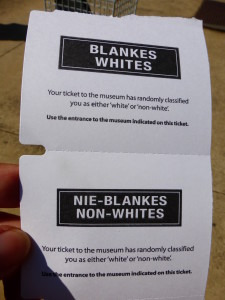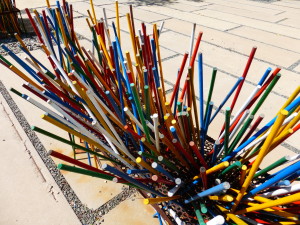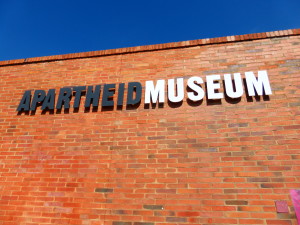 South Africa has a good museum teaching us about the ugly history that is apartheid. The Apartheid Museum in Johannesburg is a moving and thorough lesson in the history of South Africa, the apartheid movement, and the journey back to freedom.
South Africa has a good museum teaching us about the ugly history that is apartheid. The Apartheid Museum in Johannesburg is a moving and thorough lesson in the history of South Africa, the apartheid movement, and the journey back to freedom.
I was surprised and saddened to hear just how recent this Hitler-like oppression reigned here. Next week, on April 27th, 2014, South Africa will celebrate the 20th anniversary of Black Rights in South Africa. Only 20 short years ago, apartheid ended and blacks were given their first democratic vote. The country voted in the most well known non-violent anti-apartheid activist, Nelson Mandela, at the age of 75.
When arriving at the museum, the admission ticket assigns you one of two entrances – White or Non-White. You are expected to enter under the race assigned to you. It was a bit surreal. Separating from our family, we quickly learned how the mixed families of the time must have felt – torn apart based on their color or race. In 1949, the first apartheid law was passed prohibiting mixed race marriages. In 1950, the population was divided into races and segregated into different areas of town. Townships were set up outside the cities and non-whites were sent to live there. Ubiquitous others followed in subsequent years.
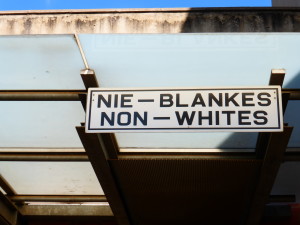 The Apartheid Museum was a through history of South Africa, from the early beginnings of early white domination to politics of the apartheid era. It included the history of the myriad of cultures up to the point of apartheid, how the mining industry was effected by the movement, and the 150 acts passed to segregate and oppress the non-whites. The museum then documents the black consciousness, the armed struggles, and the long fight for freedom. A lesson in both tragedy and freedom, the museum was both heartbreaking and moving.
The Apartheid Museum was a through history of South Africa, from the early beginnings of early white domination to politics of the apartheid era. It included the history of the myriad of cultures up to the point of apartheid, how the mining industry was effected by the movement, and the 150 acts passed to segregate and oppress the non-whites. The museum then documents the black consciousness, the armed struggles, and the long fight for freedom. A lesson in both tragedy and freedom, the museum was both heartbreaking and moving.
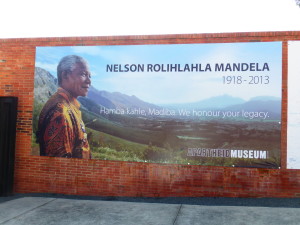 The best part of the museum for me is that we were lucky enough to tour the museum during a beautiful and inspirational exhibit on Rolihlahla Nelson Mandela. (Nelson was the name he was given on the first day of 1st grade. White teachers had trouble pronouncing African names so all African children were given European names at school.) He worked hard in school and eventually enrolled in one of the four universities which accepted black students.
The best part of the museum for me is that we were lucky enough to tour the museum during a beautiful and inspirational exhibit on Rolihlahla Nelson Mandela. (Nelson was the name he was given on the first day of 1st grade. White teachers had trouble pronouncing African names so all African children were given European names at school.) He worked hard in school and eventually enrolled in one of the four universities which accepted black students.
From the age of 30, Mandela dedicated his life to the struggle against apartheid. Truly a well spoken and powerful leader, he worked hard, at the expense of his marriage and family life to lead the struggle for universal rights for all. In 1962, he was arrested and charged with treason. Instead of pleading not-guilty (even though with a guilty verdict could be sentenced to death), he used the trial to continue his fight.
“I have dedicated myself to this struggle for the African people… I have cherished the ideal of a democratic and free society…. It is an ideal for which I am prepared to die.” – Mandela’s closing words, Rivonia Trial, June 1964.
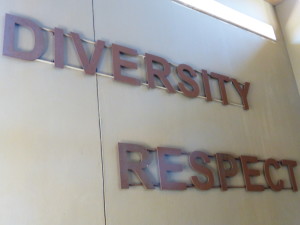 At the closing of the trial, at age of 46, he was tried and found guilty of treason. He was sentenced to life imprisonment where he spent the next 27 years in harsh conditions. Even from prison, he continued to lead his comrades and inspire others. Over the years, his anti-apartheid messages and memoirs were smuggled out. His release became one of the main protests against apartheid, and in 1990, he was finally released from prison.
At the closing of the trial, at age of 46, he was tried and found guilty of treason. He was sentenced to life imprisonment where he spent the next 27 years in harsh conditions. Even from prison, he continued to lead his comrades and inspire others. Over the years, his anti-apartheid messages and memoirs were smuggled out. His release became one of the main protests against apartheid, and in 1990, he was finally released from prison.
The road to freedom was turbulent and long but in 1994, South Africa celebrated its first ever free democratic election. Mandela was elected president.
It is hard for me to believe that this was only 20 short years ago.
South Africa has had a tough journey. The story that stands out to me is one I heard from a man about my age. He told us about a black friend of his who still habitually removes his hat when speaking to a white man. In the days of apartheid, he was repeatedly kicked if he didn’t remove his hat. Apartheid is was so recent that it leaves deep scars and this damage can take many years, and even generations, to heal. That said, the man I spoke to was pleased to see that his children were going to school with children of all races. With these children, he hopes, is where apartheid will truly end.
To quote one of the greats:
There can be no keener revelation of a society’s soul than the way in which it treats is children. – Nelson Mandela
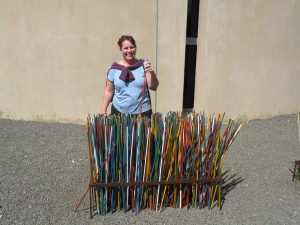 To end our tour of the Apartheid Museum, we were presented with dozens of Mandela’s inspirational quotes on peace, humility, forgiveness, courage, and freedom. We could pick the one we were most inspired by and, by a color represented stick, place it in the garden. It was a beautiful way to end the day on hope.
To end our tour of the Apartheid Museum, we were presented with dozens of Mandela’s inspirational quotes on peace, humility, forgiveness, courage, and freedom. We could pick the one we were most inspired by and, by a color represented stick, place it in the garden. It was a beautiful way to end the day on hope.
